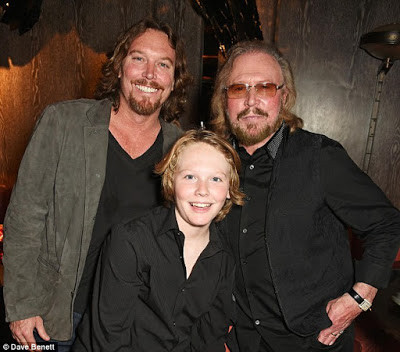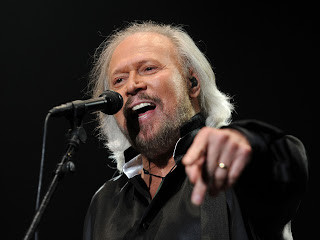Celebrating four decades since it topped the charts, Barry Gibb revisits the magic behind the Bee Gees’ iconic disco anthem, “You Should Be Dancing.” This deep dive into the song’s creation reveals fascinating insights, far beyond just the memorable “Should Be Dancing Bee Gees Lyrics” that fans worldwide know and love. In a recent interview, Gibb shared the intricate process and surprising details that made this track a global phenomenon. Let’s explore the story of how this dance floor filler came to life.
The Genesis of a Disco Anthem
The conversation began with a charming anecdote about family and dance. Reflecting on a photo taken in London with his son Ashley and grandson Lucas, Barry Gibb chuckled about Lucas’s unexpected dance prowess at a Sony summer party. “This kid’s got some fantastic moves,” Gibb beamed, recalling the surprise and delight of seeing his grandson take over the dance floor. This led to a natural segue into discussing another dance-related milestone: the 40th anniversary of “You Should Be Dancing” reaching number one in the US charts.
The interviewer, Tim Roxborogh, cleverly linked the youthful energy of Gibb’s grandson to the timeless energy of “You Should Be Dancing,” prompting Gibb to delve into the memories of creating this legendary track. Roxborogh touched upon the song’s rich layers, mentioning Stephen Stills’s contribution on percussion and the rumored sixteen layers of percussion. He asked Gibb to share some “fun things” he remembered from the recording sessions.
Recording Secrets Revealed
Gibb’s response unveiled a meticulous and iterative creative process. Far from being a spontaneous hit, “You Should Be Dancing” was painstakingly crafted. “Oh I remember a lot of that song,” Gibb began, “I remember that we cut the track at least four times.” He emphasized the relentless pursuit of perfection, noting the constant refinements over a two-week period. This dedication to detail highlights the effort behind what seems like an effortlessly groovy track.
He painted a picture of Stephen Stills contributing percussion in the early hours of the morning, using “sticks,” and described an environment of discovery. The Miami setting played a crucial role, immersing them in Latin rhythms that naturally seeped into their music. This blend of influences contributed to the unique sound that made “You Should Be Dancing” stand out. Gibb vividly recalled, “We were discovering more accurate rhythms, we were discovering Latin rhythms and because we lived in Miami that was all around us so it just happened that way, you know? But it’s still very vivid.”
Barry’s Falsetto Trumpet and Mixing Magic
Roxborogh then shared his recent discovery of Gibb’s falsetto doubling the trumpet solo, a hidden gem revealed by isolated vocal tracks on YouTube. Gibb confirmed this, explaining their experimental approach in the studio. With newly available多轨录音 technology, they were eager to add layers and unusual elements. He even mentioned creating the explosion sound in “Tragedy” using only his mouth, showcasing their innovative sound design techniques.
“With You Should Be Dancing it was the sudden emergence of having as many tracks as you wanted. So you would always add something else that made it unusual,” Gibb explained. He also revealed that he sang the instrumental parts in “Jive Talkin’,” further illustrating their commitment to layering vocals to create a richer sonic texture.
The mixing process for “You Should Be Dancing” was particularly challenging and collaborative. Gibb recounted that it took ten people at the mixing board simultaneously to get it right. In a pre-digital era, mixing was a live performance in itself. Each person controlled specific faders, and Barry Gibb’s crucial role was managing the echo repeat on the line “Whatcha’ doin’ on ya’ back?” – a key phrase within the “should be dancing bee gees lyrics” that adds to the song’s infectious rhythm.
“My fader was the repeat of the echo of (breaking into falsetto) ‘Whatcha’ doin’ on ya’ back?’ There’s a little repeat on that…” Gibb demonstrated, highlighting the manual, high-stakes nature of mixing in those days. If anyone made a mistake, the entire mix had to be restarted.
From Studio to Smash Hit
Roxborogh then posed the question of whether the Bee Gees knew they had a smash hit on their hands while mixing the track. Gibb offered a nuanced perspective, stating that while artists can rarely predict chart success, they recognized the song’s special quality. “Well I don’t think you can ever say that about any song. I think you can look at each other and go, ‘this is great. This is special.'”
He admitted that “Islands In The Stream” felt like a number one record even before it was recorded and that “How Deep Is Your Love” also carried a strong sense of destiny. With “You Should Be Dancing,” the inspiration was different. It stemmed from a collective desire to create music that mirrored the burgeoning dance craze. “…suddenly everyone was wanting to dance and we wanted to make a record like that. So I think it was us doing that.”
Gibb likened this inspiration to Paul McCartney’s admiration for the Beach Boys, where artists are sometimes driven to emulate and build upon the work of those they admire. While “You Should Be Dancing” might have been inspired by the danceable sounds of the era, “How Deep Is Your Love,” he noted, was a completely original creation, born purely from feeling.
In conclusion, the story of “You Should Be Dancing” is more than just catchy “should be dancing bee gees lyrics”; it’s a tale of meticulous craftsmanship, studio experimentation, and a cultural moment perfectly captured in song. Barry Gibb’s insights offer a fascinating glimpse into the making of a disco classic, reminding us that behind every seemingly simple hit, there’s often a world of dedication and innovation. For those wanting to further appreciate the Bee Gees’ vocal artistry, listening to the vocals-only version is highly recommended, and exploring Barry Gibb’s new album “In The Now” offers a contemporary perspective from this music legend.


